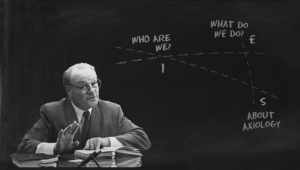By Jim Whitt
Having personally witnessed the inhumanity accompanying Hitler’s rise to power in pre-war Germany, Dr. Robert S. Hartman envisioned a science which could organize good as effectively as the Nazis organized evil. After years of research, Hartman created a new mathematical system called Axiology which successfully orders the values of our everyday experiences. Derived from two Greek words — xios (worth or value) and logos (logic or theory) — Axiology examines “how we think” and helps us to understand the patterns we use to make judgments.
Hartman identified three distinct dimensions of how we judge and value things:
Systemic – The dimension of formal concepts, ideals, goals, structured thinking, policies, procedures, rules, laws, “oughts” and “shoulds.” It is one of perfection.
Extrinsic – This is the dimension of comparisons, relative and practical thinking. It includes the elements of the real, material world, comparisons of good/better/best, and seeing things as they compare with other things in their class
Intrinsic – The dimension of uniqueness and singularity. It includes people, love, feelings, etc.
Everyone has different strengths and weaknesses in their ability to apply these three dimensions when making decisions. No one uses each dimension equally to make a decision.
From a systemic point of view, we measure people against a standard. It can be a system of policies, procedures, rules, laws or a religion. This is a black or white comparison. It’s either pass or fail.
When we examine people extrinsically, we see them comparatively. They are better than, worse than or about the same as someone else, relatively speaking
If we view people intrinsically we value them for their uniqueness, their essence, their spiritual being. They are the one and only.
We not only view others but ourselves through the prism of these same three dimensions. If we see ourselves purely through systemic eyes, we’ll be frustrated failures. No one can live up to all the rules of any system — even if we get to make the rules.
From an extrinsic viewpoint, we either think more highly of ourselves than we ought or find ourselves lacking.
It is only when you look into the eyes of your soul and view yourself intrinsically that you understand your true value. When viewed from an intrinsic point of view you see yourself exactly as your Creator sees you. You are the one and only. Just as no two snowflakes are alike, you are singularly unique.
Dr. Hartman devoted his life to answering the question, “What is good?” The conclusion he reached was, “A thing is good when it fulfills its definition.” Good can be defined as “certain to elicit a specific result” and “something conforming to the moral order of the universe.”
Your purpose is God’s definition of you. You were created to elicit a specific result. When you are fulfilling your purpose you are conforming to the moral order of the universe.
That is good.



